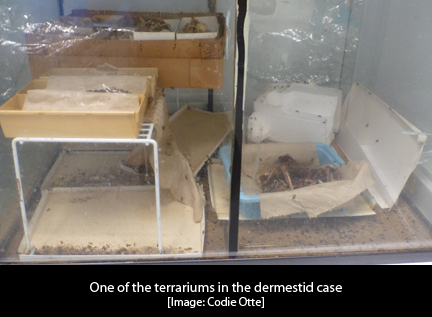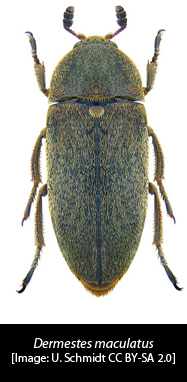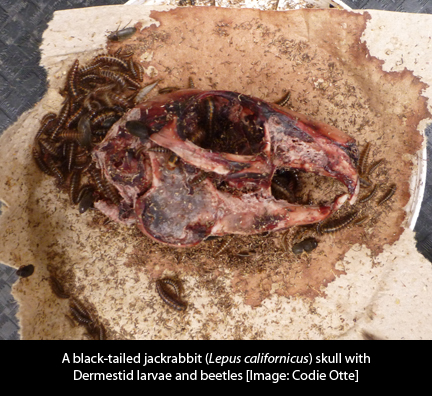Two weeks ago in our Project Lab blog, Laura spoke about masceration and briefly touched on the role dermestid beetles play in skeletonizing specimens for the O&M department. Working with the beetles is one of my favorite aspects of my job here at the Academy and I thought I would go into a bit more detail regarding our wonderful, interesting dermestid colony!

Dermestid beetles (family Dermestidae) are a large group of scavenger beetles that feed on a variety of organic materials from hair to skin to dead flesh. Dermestids can be found on carcasses almost anywhere in the world! Taxidermists and scientific preparators have long used these beetles to help quickly and efficiently clean bones of flesh because the beetles do most of the work for us! Out in the O&M Bones Lab, we use a colony of Dermestes maculatus, a small black beetle with a white ventral side, to help prepare skeletons for the research collection.

Dermestids are perfect for terrarium life as the right hand “man” of the preparator. Although capable of flight, our Dermestes maculatus don’t take to wing unless they get too hot, so we keep our terrarium case pleasantly warm to keep the beetles happy just strolling around. This makes opening and closing their case much easier and prevents beetles from escaping and munching on other specimens. They also require little care aside from feeding and the occasional spritz of water. The work they do for our department vastly outweighs their salary (all paid in food!).
The first step in skeletonizing a specimen is to remove most of the flesh off the animal, leaving only a small amount of muscle on the bones. Up in the Project Lab, you can find O&M staff and volunteers regularly skeletonizing specimens for our research collection. Once the muscle has been removed, it is time for the dermestid colony to begin their work.

A large colony will be able to strip a small bird clean in just a few days! Dermestid beetles are excellent for cleaning small, delicate skeletons like fragile passerine birds and tiny mammals, and also juvenile species whose bones have not yet fused. Sometimes with water masceration (as described by Laura in her previous post), skeletons can fall apart from being submerged in liquid for long periods of time. In contrast, the dermestid beetles will eat the flesh off the bones and generally keep the skeleton articulated and this can be preferable for some specimens to prevent important sutures from falling apart.

Once cleaned by the dermestids, the skeleton will be brightened and degreased and then integrated into our collection, ready to be used by a curious researcher… maybe you!
Codie Otte Curatorial Assistant and Specimen Preparator Ornithology & Mammalogy Department